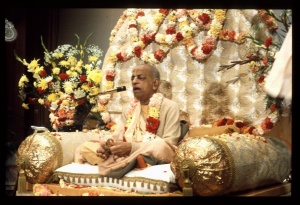BG 1.20: Difference between revisions
m (1 revision(s)) |
(Vanibot #0054 edit - transform synonyms into clickable links, which search similar occurrences) |
||
| (One intermediate revision by one other user not shown) | |||
| Line 1: | Line 1: | ||
{{ | [[Category:Bhagavad-gita As It Is (1983+) - Chapter 01]] | ||
<div style="float:left">'''[[Bhagavad-gita As It Is (1983+)]] - [[BG 1 (1983+)|Chapter 1: Observing the Armies on the Battlefield of Kuruksetra]]'''</div> | |||
<div style="float:right">[[File:Go-previous.png|link=BG 1.19]] '''[[BG 1.19]] - [[BG 1.21-22]]''' [[File:Go-next.png|link=BG 1.21-22]]</div> | |||
{{CompareVersions|BG|1.20|BG 1972|BG 1983+}} | |||
{{RandomImage}} | |||
==== TEXT 20 ==== | ==== TEXT 20 ==== | ||
<div class="devanagari"> | |||
:अथ व्यवस्थितान्दृष्ट्वा धार्तराष्ट्रान् कपिध्वजः । | |||
:प्रवृत्ते शस्त्रसम्पाते धनुरुद्यम्य पाण्डवः । | |||
:हृषीकेशं तदा वाक्यमिदमाह महीपते ॥२०॥ | |||
</div> | |||
<div | <div class="verse"> | ||
:atha vyavasthitān dṛṣṭvā | |||
:dhārtarāṣṭrān kapi-dhvajaḥ | |||
:pravṛtte śastra-sampāte | |||
:dhanur udyamya pāṇḍavaḥ | |||
:hṛṣīkeśaṁ tadā vākyam | |||
:idam āha mahī-pate | |||
</div> | </div> | ||
==== SYNONYMS ==== | ==== SYNONYMS ==== | ||
<div class="synonyms"> | |||
<div | ''[//vanipedia.org/wiki/Special:VaniSearch?s=atha&tab=syno_o&ds=1 atha]'' — thereupon; ''[//vanipedia.org/wiki/Special:VaniSearch?s=vyavasthitān&tab=syno_o&ds=1 vyavasthitān]'' — situated; ''[//vanipedia.org/wiki/Special:VaniSearch?s=dṛṣṭvā&tab=syno_o&ds=1 dṛṣṭvā]'' — looking upon; ''[//vanipedia.org/wiki/Special:VaniSearch?s=dhārtarāṣṭrān&tab=syno_o&ds=1 dhārtarāṣṭrān]'' — the sons of Dhṛtarāṣṭra; ''[//vanipedia.org/wiki/Special:VaniSearch?s=kapi&tab=syno_o&ds=1 kapi]-[//vanipedia.org/wiki/Special:VaniSearch?s=dhvajaḥ&tab=syno_o&ds=1 dhvajaḥ]'' — he whose flag was marked with Hanumān; ''[//vanipedia.org/wiki/Special:VaniSearch?s=pravṛtte&tab=syno_o&ds=1 pravṛtte]'' — while about to engage; ''[//vanipedia.org/wiki/Special:VaniSearch?s=śastra&tab=syno_o&ds=1 śastra]-[//vanipedia.org/wiki/Special:VaniSearch?s=sampāte&tab=syno_o&ds=1 sampāte]'' — in releasing his arrows; ''[//vanipedia.org/wiki/Special:VaniSearch?s=dhanuḥ&tab=syno_o&ds=1 dhanuḥ]'' — bow; ''[//vanipedia.org/wiki/Special:VaniSearch?s=udyamya&tab=syno_o&ds=1 udyamya]'' — taking up; ''[//vanipedia.org/wiki/Special:VaniSearch?s=pāṇḍavaḥ&tab=syno_o&ds=1 pāṇḍavaḥ]'' — the son of Pāṇḍu (Arjuna); ''[//vanipedia.org/wiki/Special:VaniSearch?s=hṛṣīkeśam&tab=syno_o&ds=1 hṛṣīkeśam]'' — unto Lord Kṛṣṇa; ''[//vanipedia.org/wiki/Special:VaniSearch?s=tadā&tab=syno_o&ds=1 tadā]'' — at that time; ''[//vanipedia.org/wiki/Special:VaniSearch?s=vākyam&tab=syno_o&ds=1 vākyam]'' — words; ''[//vanipedia.org/wiki/Special:VaniSearch?s=idam&tab=syno_o&ds=1 idam]'' — these; ''[//vanipedia.org/wiki/Special:VaniSearch?s=āha&tab=syno_o&ds=1 āha]'' — said; ''[//vanipedia.org/wiki/Special:VaniSearch?s=mahī&tab=syno_o&ds=1 mahī]-[//vanipedia.org/wiki/Special:VaniSearch?s=pate&tab=syno_o&ds=1 pate]'' — O King. | ||
</div> | </div> | ||
==== TRANSLATION ==== | ==== TRANSLATION ==== | ||
<div class="translation"> | |||
<div | |||
At that time Arjuna, the son of Pāṇḍu, seated in the chariot bearing the flag marked with Hanumān, took up his bow and prepared to shoot his arrows. O King, after looking at the sons of Dhṛtarāṣṭra drawn in military array, Arjuna then spoke to Lord Kṛṣṇa these words. | At that time Arjuna, the son of Pāṇḍu, seated in the chariot bearing the flag marked with Hanumān, took up his bow and prepared to shoot his arrows. O King, after looking at the sons of Dhṛtarāṣṭra drawn in military array, Arjuna then spoke to Lord Kṛṣṇa these words. | ||
</div> | </div> | ||
==== PURPORT ==== | |||
= | <div class="purport"> | ||
The battle was just about to begin. It is understood from the above statement that the sons of Dhṛtarāṣṭra were more or less disheartened by the unexpected arrangement of military force by the Pāṇḍavas, who were guided by the direct instructions of Lord Kṛṣṇa on the battlefield. The emblem of Hanumān on the flag of Arjuna is another sign of victory because Hanumān cooperated with Lord Rāma in the battle between Rāma and Rāvaṇa, and Lord Rāma emerged victorious. Now both Rāma and Hanumān were present on the chariot of Arjuna to help him. Lord Kṛṣṇa is Rāma Himself, and wherever Lord Rāma is, His eternal servitor Hanumān and His eternal consort Sītā, the goddess of fortune, are present. Therefore, Arjuna had no cause to fear any enemies whatsoever. And above all, the Lord of the senses, Lord Kṛṣṇa, was personally present to give him direction. Thus, all good counsel was available to Arjuna in the matter of executing the battle. In such auspicious conditions, arranged by the Lord for His eternal devotee, lay the signs of assured victory. | |||
</div> | |||
<div | <div style="float:right; clear:both;">[[File:Go-previous.png|link=BG 1.19]] '''[[BG 1.19]] - [[BG 1.21-22]]''' [[File:Go-next.png|link=BG 1.21-22]]</div> | ||
__NOTOC__ | |||
</div> | __NOEDITSECTION__ | ||
__NOTOC__ | |||
Latest revision as of 15:11, 17 February 2024

A.C. Bhaktivedanta Swami Prabhupada
TEXT 20
- अथ व्यवस्थितान्दृष्ट्वा धार्तराष्ट्रान् कपिध्वजः ।
- प्रवृत्ते शस्त्रसम्पाते धनुरुद्यम्य पाण्डवः ।
- हृषीकेशं तदा वाक्यमिदमाह महीपते ॥२०॥
- atha vyavasthitān dṛṣṭvā
- dhārtarāṣṭrān kapi-dhvajaḥ
- pravṛtte śastra-sampāte
- dhanur udyamya pāṇḍavaḥ
- hṛṣīkeśaṁ tadā vākyam
- idam āha mahī-pate
SYNONYMS
atha — thereupon; vyavasthitān — situated; dṛṣṭvā — looking upon; dhārtarāṣṭrān — the sons of Dhṛtarāṣṭra; kapi-dhvajaḥ — he whose flag was marked with Hanumān; pravṛtte — while about to engage; śastra-sampāte — in releasing his arrows; dhanuḥ — bow; udyamya — taking up; pāṇḍavaḥ — the son of Pāṇḍu (Arjuna); hṛṣīkeśam — unto Lord Kṛṣṇa; tadā — at that time; vākyam — words; idam — these; āha — said; mahī-pate — O King.
TRANSLATION
At that time Arjuna, the son of Pāṇḍu, seated in the chariot bearing the flag marked with Hanumān, took up his bow and prepared to shoot his arrows. O King, after looking at the sons of Dhṛtarāṣṭra drawn in military array, Arjuna then spoke to Lord Kṛṣṇa these words.
PURPORT
The battle was just about to begin. It is understood from the above statement that the sons of Dhṛtarāṣṭra were more or less disheartened by the unexpected arrangement of military force by the Pāṇḍavas, who were guided by the direct instructions of Lord Kṛṣṇa on the battlefield. The emblem of Hanumān on the flag of Arjuna is another sign of victory because Hanumān cooperated with Lord Rāma in the battle between Rāma and Rāvaṇa, and Lord Rāma emerged victorious. Now both Rāma and Hanumān were present on the chariot of Arjuna to help him. Lord Kṛṣṇa is Rāma Himself, and wherever Lord Rāma is, His eternal servitor Hanumān and His eternal consort Sītā, the goddess of fortune, are present. Therefore, Arjuna had no cause to fear any enemies whatsoever. And above all, the Lord of the senses, Lord Kṛṣṇa, was personally present to give him direction. Thus, all good counsel was available to Arjuna in the matter of executing the battle. In such auspicious conditions, arranged by the Lord for His eternal devotee, lay the signs of assured victory.